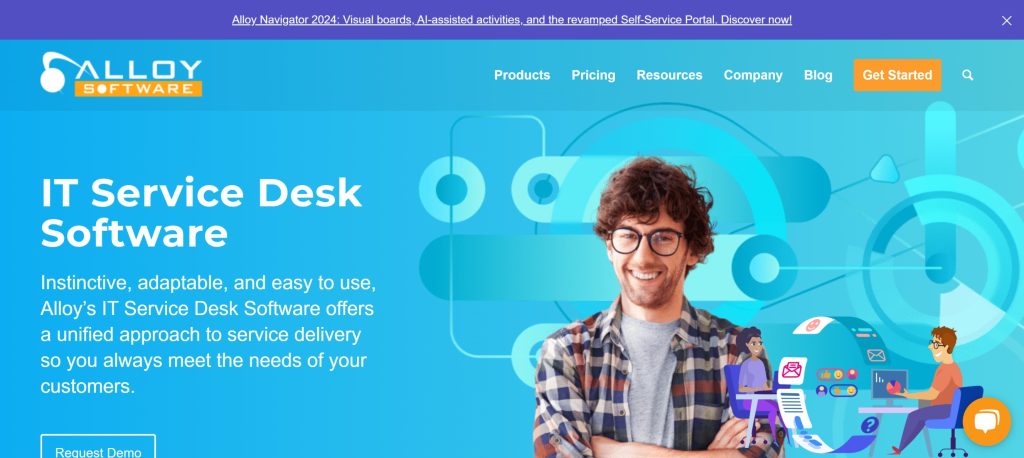When managing IT services and assets, a robust solution is essential to maintain efficiency, reliability, and compliance. Alloy Navigator is a powerful tool designed to simplify IT service management (ITSM), streamline operations, and enhance collaboration within teams. Whether you’re new to Alloy Navigator or looking to expand your understanding of its capabilities, this guide provides a detailed overview to help you get started and make the most of its features.
Table of Contents
At its core, Alloy Navigator is an all-in-one ITSM solution tailored to businesses of all sizes. From managing IT assets and automating workflows to tracking incidents and improving customer support, Alloy Navigator stands out as a comprehensive platform that integrates seamlessly into your organization’s processes. Its versatility ensures that both IT professionals and end-users can collaborate effortlessly, fostering better productivity and satisfaction.
One of the standout features of Alloy Navigator is its focus on user experience. Unlike other platforms that overwhelm users with complex interfaces, this solution emphasizes simplicity and usability, making it accessible for beginners while providing advanced tools for seasoned professionals.
1. Centralized Asset Management:
Alloy Navigator helps organizations maintain a centralized inventory of hardware, software, and other IT asset management software. This ensures better control, reduces redundancy, and improves decision-making.
2. Customizable Workflows:
Every organization has unique processes, and Alloy Navigator caters to that with its customizable workflows. You can design and automate processes that align with your business goals, from incident resolution to change management.
3. Enhanced Reporting and Analytics:
Data is the backbone of informed decision-making. With Alloy Navigator, you gain access to robust reporting tools that provide actionable insights, helping you track performance and identify areas for improvement.
4. Scalability for Growing Businesses:
Whether you’re a small team or a large enterprise, Alloy Navigator scales effortlessly to meet your evolving needs, ensuring a consistent experience regardless of your organization’s size.
Comprehensive Help Desk Support:
Managing support tickets becomes a breeze with Alloy Navigator’s intuitive interface. Tickets can be tracked from submission to resolution, ensuring transparency and efficiency. Additionally, its self-service portal empowers users to find solutions quickly without relying on IT staff.
Seamless Integration:
Alloy Navigator integrates seamlessly with other tools and platforms, including Active Directory, email clients, and network monitoring solutions. This ensures a unified approach to IT management without the need for multiple systems.
User-Friendly Interface:
Navigating the Alloy Navigator platform feels natural, even for non-technical users. Its dashboard is clean, customizable, and packed with all the essential tools you need to stay organized.
Step 1: Familiarize Yourself with the Interface
Begin by exploring the platform’s layout. Alloy Navigator’s dashboard is designed for intuitive navigation, so take your time to understand where different features and tools are located.
Step 2: Configure Your Settings
Customizing the platform to align with your organization’s needs is crucial. Set up user roles, permissions, and preferences to ensure that everyone on your team has access to the tools they need.
Step 3: Import Your Data
Migrate your existing IT asset data into Alloy Navigator. The platform offers tools to streamline this process, reducing manual effort and ensuring accuracy.
Step 4: Automate Workflows
Leverage Alloy Navigator’s automation features to create workflows for ticketing, approvals, and escalations. Automation saves time and minimizes errors, enabling your team to focus on higher-value tasks.
Step 5: Train Your Team
Even the best tools require proper training. Host workshops or provide resources to help your team get acquainted with Alloy Navigator’s features and functionalities.

To truly unlock the full potential of Alloy Navigator, it’s essential to adopt certain best practices:
- Regularly Update Asset Information: Keep your asset inventory current to ensure accurate reporting and compliance.
- Leverage Reports: Use the platform’s analytics to identify trends, improve efficiency, and make data-driven decisions.
- Encourage User Feedback: Your team’s feedback can uncover valuable insights into how the platform can be optimized to meet their needs.
- Utilize Support Resources: Alloy Software offers excellent customer support and resources to help you tackle any challenges you might encounter.
Alloy Navigator is more than just a tool—it’s a strategic partner in your IT management journey. Whether you’re looking to improve efficiency, enhance customer satisfaction, or reduce operational costs, this platform delivers results that align with your goals. Ready to explore its features in detail? Visit https://www.alloysoftware.com/ for comprehensive information and support.
By integrating Alloy Navigator into your IT operations, you’ll empower your team with the tools they need to succeed while ensuring your organization stays ahead in a competitive landscape.
This guide is your starting point for understanding the power of Alloy Navigator. Dive in, explore its features, and transform the way you manage your IT services today!

Andrej Fedek is the creator and the one-person owner of two blogs: InterCool Studio and CareersMomentum. As an experienced marketer, he is driven by turning leads into customers with White Hat SEO techniques. Besides being a boss, he is a real team player with a great sense of equality.
